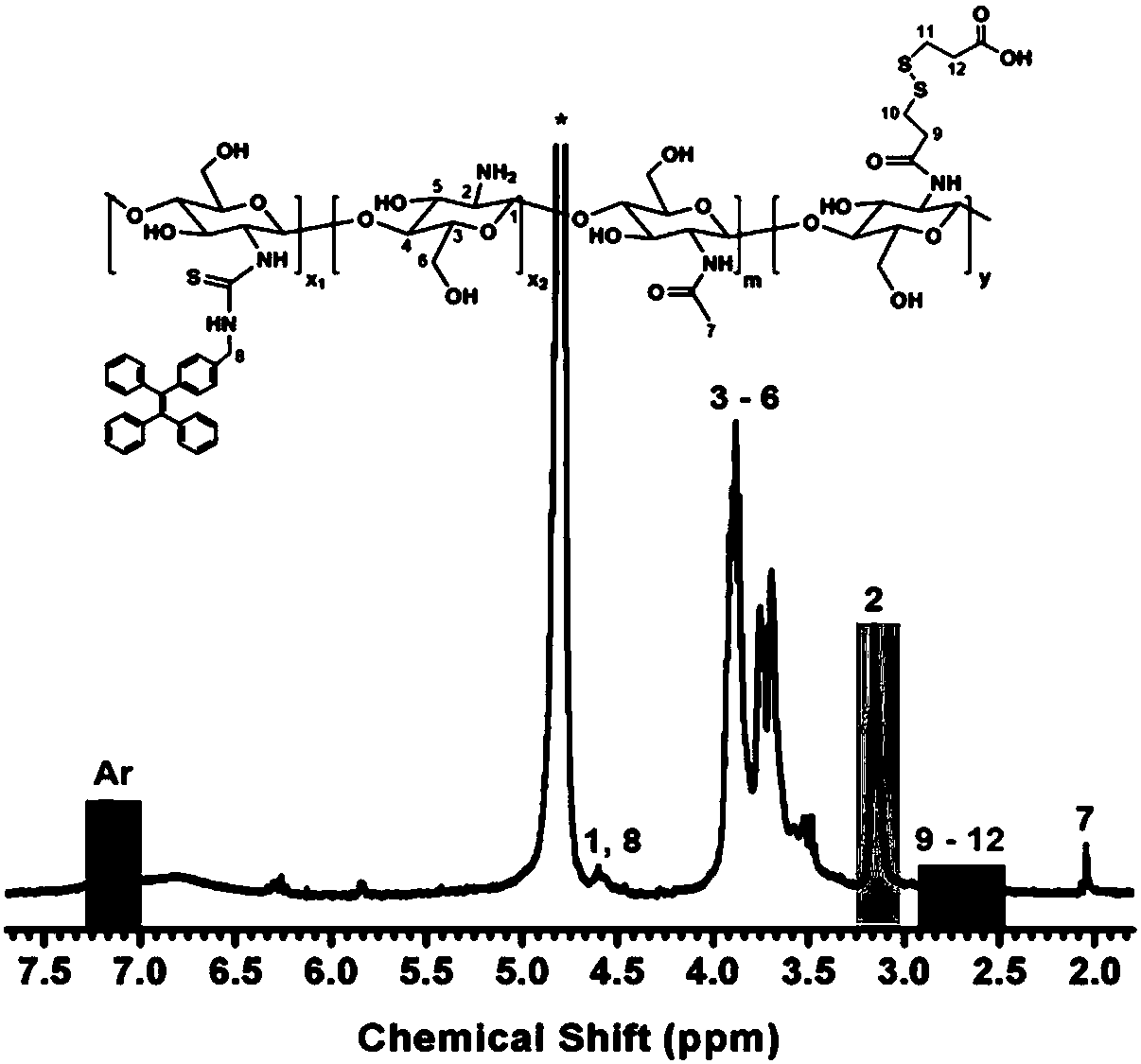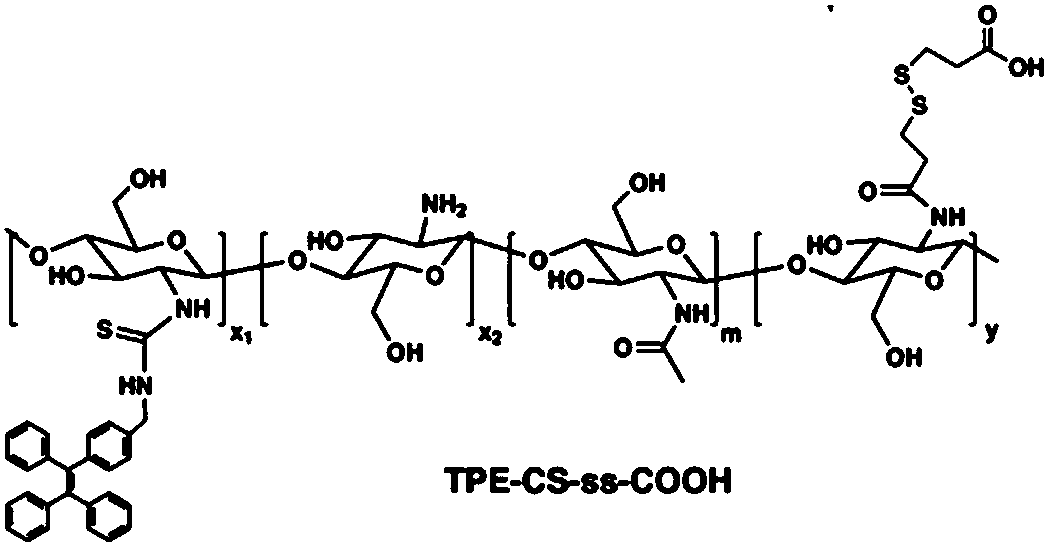Preparation method of water-soluble chitosan-based aggregation-induced emission fluorescent probe with reduction responsiveness
A water-soluble chitosan, aggregation-induced luminescence technology, applied in fluorescence/phosphorescence, material excitation analysis, material analysis by optical means, etc., can solve the problems of small molecule fluorescent probe penetration, leakage, detection error, etc. Good reduction responsiveness and water solubility, no shift in fluorescence spectrum, and high sensitivity
- Summary
- Abstract
- Description
- Claims
- Application Information
AI Technical Summary
Problems solved by technology
Method used
Image
Examples
Embodiment 1
[0023] 1) Weigh 1g chitosan (viscosity-average molecular weight is 10,000, degree of deacetylation 60%) and join in 100mL beaker, add 0.1mol / L HCl solution of 50mL in beaker, obtain chitosan concentration after stirring evenly Solution A of 0.02g / mL;
[0024] 2) Weigh a certain amount of dithiodipropionic acid (DTDP) and add it to a three-necked flask, so that the molar ratio of DTDP to the amino group on the chitosan chain is 1:1, and then add a certain amount of 1-ethyl- (3-Dimethylaminopropyl) carbodiimide hydrochloride (EDC) and N-hydroxysuccinimide (NHS), make the molar ratio of DTDP and EDC be 1:1.2, and the molar ratio of EDC and NHS The ratio is 1:1, add an appropriate amount of anhydrous methanol to the three-necked flask to make the concentration of DTDP 0.01g / mL, and activate it in an ice bath at 0°C for 0.5h to obtain solution B;
[0025] 3) Use a constant pressure dropping funnel to add solution A dropwise to solution B, adjust the pH of the system to 4.0 with 1m...
Embodiment 2
[0032] 1) Weigh 2g chitosan (viscosity average molecular weight is 100,000, degree of deacetylation 65%) and join in 100mL beaker, add 50mL of 0.1mol / L HCl solution in beaker, obtain chitosan concentration after stirring evenly Solution A of 0.04g / mL;
[0033] 2) Weigh a certain amount of dithiodipropionic acid (DTDP) and add it to a three-necked flask so that the molar ratio of DTDP to the amino group on the chitosan chain is 1.2:1, and then add a certain amount of 1-ethyl- (3-Dimethylaminopropyl) carbodiimide hydrochloride (EDC) and N-hydroxysuccinimide (NHS), make the molar ratio of DTDP and EDC be 1:1.4, and the molar ratio of EDC and NHS The ratio is 1:1.4, add an appropriate amount of anhydrous methanol to the three-necked flask to make the concentration of DTDP 0.02g / mL, and activate it in an ice bath at 2°C for 1 hour to obtain solution B;
[0034] 3) Use a constant pressure dropping funnel to add solution A dropwise to solution B, adjust the pH of the system to 4.5 w...
Embodiment 3
[0041] 1) Weigh 0.5g chitosan (viscosity-average molecular weight is 300,000, degree of deacetylation 70%) and join in a 100mL beaker, add 50mL of 0.1mol / L HCl solution in the beaker, stir to obtain chitosan Solution A with a concentration of 0.01g / mL;
[0042] 2) Weigh a certain amount of dithiodipropionic acid (DTDP) and add it to a three-necked flask so that the molar ratio of DTDP to the amino group on the chitosan chain is 1.4:1, and then add a certain amount of 1-ethyl- (3-Dimethylaminopropyl) carbodiimide hydrochloride (EDC) and N-hydroxysuccinimide (NHS), make the molar ratio of DTDP and EDC be 1:1.6, and the molar ratio of EDC and NHS The ratio is 1:1.1, add an appropriate amount of anhydrous methanol to the three-necked flask to make the concentration of DTDP 0.02g / mL, and activate it in an ice bath at 1°C for 1.5h to obtain solution B;
[0043] 3) Use a constant pressure dropping funnel to add solution A dropwise to solution B, adjust the pH of the system to 4.8 wi...
PUM
| Property | Measurement | Unit |
|---|---|---|
| Concentration | aaaaa | aaaaa |
| Concentration | aaaaa | aaaaa |
| Concentration | aaaaa | aaaaa |
Abstract
Description
Claims
Application Information
 Login to View More
Login to View More - R&D
- Intellectual Property
- Life Sciences
- Materials
- Tech Scout
- Unparalleled Data Quality
- Higher Quality Content
- 60% Fewer Hallucinations
Browse by: Latest US Patents, China's latest patents, Technical Efficacy Thesaurus, Application Domain, Technology Topic, Popular Technical Reports.
© 2025 PatSnap. All rights reserved.Legal|Privacy policy|Modern Slavery Act Transparency Statement|Sitemap|About US| Contact US: help@patsnap.com



